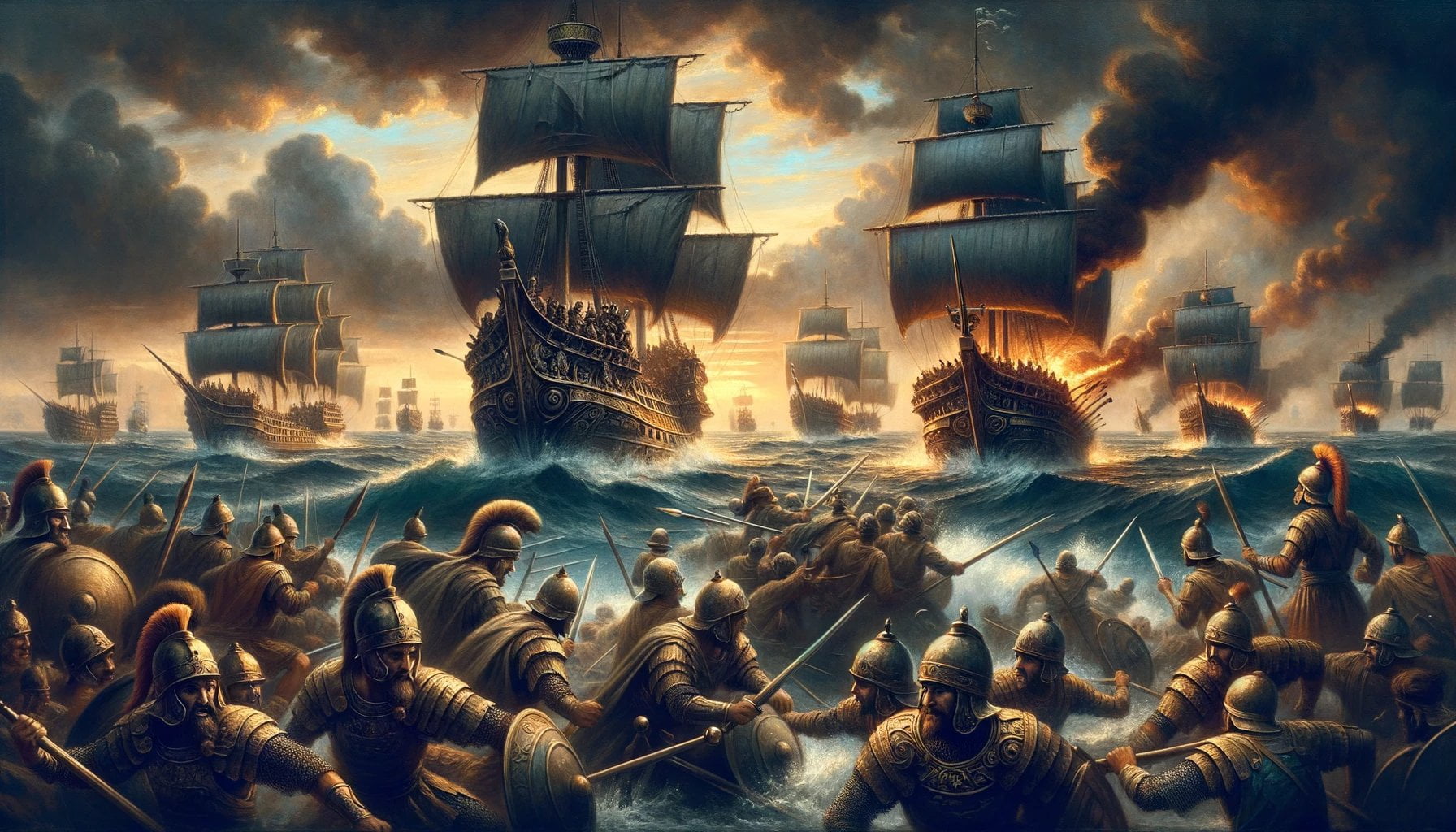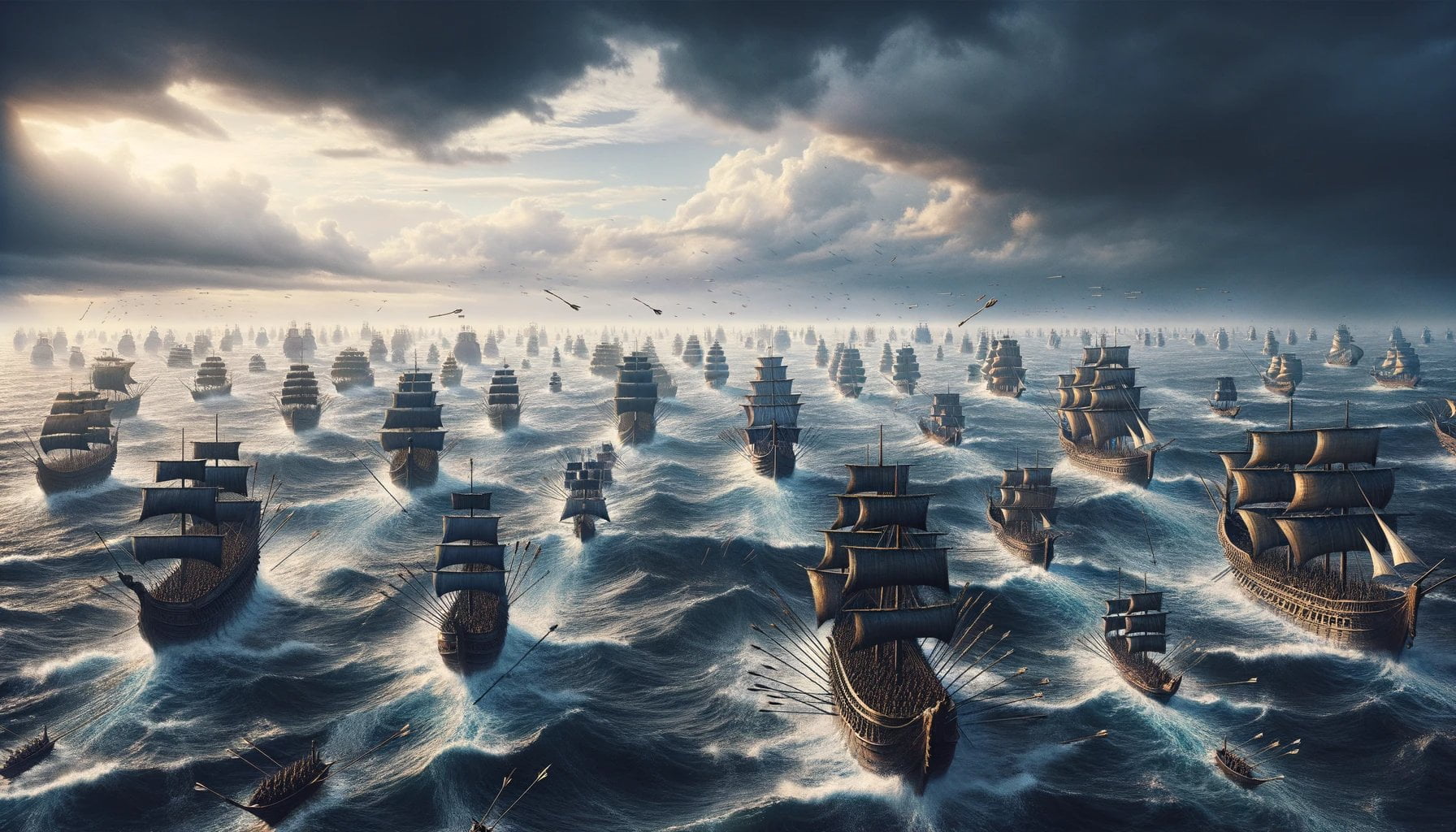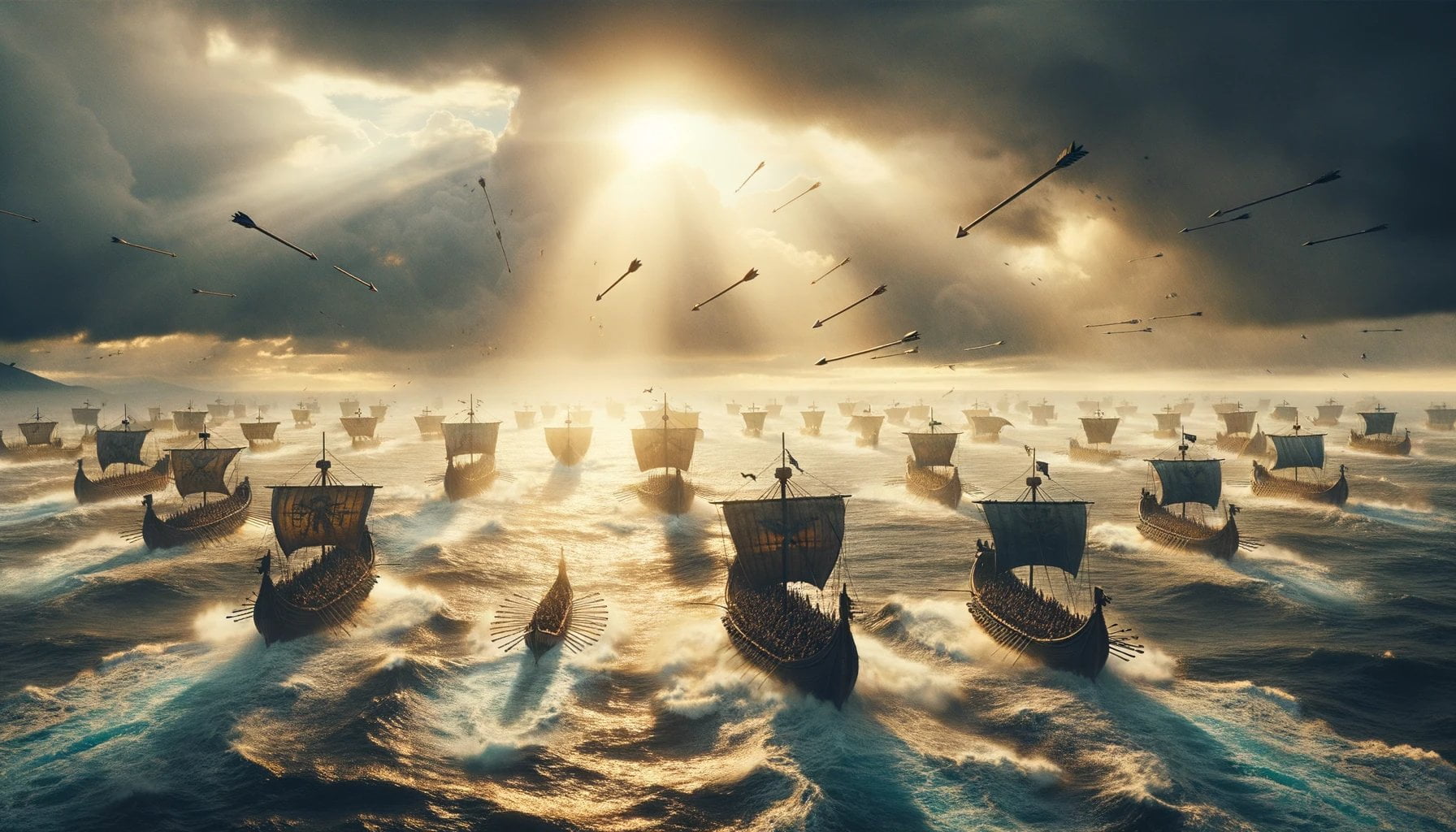Delve into the depths of ancient history’s largest naval battles and discover the epic impact they had on the course of civilizations. From the monumental clashes at Cape Ecnomus, famous for being the greatest naval battle of the ancient era, to the legendary Battle of Salamis, one of the largest naval battles in antiquity, and the awe-inspiring Battle of Red Cliffs, widely regarded as the greatest naval battle in history, to the modern warfare masterpiece, the Battle of Leyte Gulf, the largest naval battle in the history of modern warfare. Uncover the decisive factors, technological advancements, and political implications that still resonate today, shaping the world as we know it.

Key Takeaways:
- The Battle of Cape Ecnomus was fought off southern Sicily in 256 BC between Carthage and the Roman Republic during the First Punic War.
- It was the largest battle of the war and one of the largest naval battles in history.
- The outcome of the battle was a Roman victory.
- The commanders of the fleets involved in the battle were not mentioned.
- The exact number of ships involved in the battle is unknown.
- The specific weapons used in the battle are not specified.
- The Battle of Cape Ecnomus played a significant role in shaping the ancient world and had profound political implications.
- Further research, historical accounts, and archaeological findings are necessary to fully understand the complexities and impact of this monumental event.
Unraveling the Intricacies of the Largest Naval Battle in Ancient History
The ancient world was witness to numerous battles that shaped the course of history. Among these clashes, the largest naval battle in ancient history stands at the forefront, capturing the imagination with its immense scale and profound impact. This monumental event, known as the Battle of Cape Ecnomus, occurred during the First Punic War, pitting the fleets of Carthage against the Roman Republic.
Setting the Stage
In the year 256 BC, off the southern coast of Sicily, the opposing forces of Carthage and Rome clashed in a battle that would determine the fate of the war. The Battle of Cape Ecnomus marked a turning point in naval warfare, as it involved an unprecedented number of vessels and showcased the strategy and skill of both armies.
A Triumph of Roman Strategy
While historical accounts do not provide specific details about the commanders or the exact number of ships involved, the Battle of Cape Ecnomus was undoubtedly a Roman victory. It was a triumph achieved through strategic brilliance and adaptability.
Decisive Factors and Technological Advancements
To understand the significance of this ancient clash, it is crucial to delve into the decisive factors and technological advancements that played a crucial role. In the First Punic War, the Romans faced the challenge of overcoming Carthage’s naval supremacy. To counter this, the Romans developed a technique known as the “corvus,” a boarding device that enabled them to turn naval battles into hand-to-hand combat.
With the corvus, the Romans expertly used their superior infantry to outmaneuver and outfight the Carthaginian navy. The battle is a testament to Roman innovation and adaptability in the face of maritime challenges. Although accounts do not mention the specific weapons employed, it is reasonable to imagine a range of projectile weaponry and naval tactics in play.
Political Ramifications and Shaping the Ancient World
Beyond its tactical implications, the Battle of Cape Ecnomus had far-reaching political ramifications. Roman victory in this largest naval battle in ancient history paved the way for their ultimate dominance over the Mediterranean region. It weakened Carthage’s strength at sea, enabling Rome to establish its naval supremacy and expand its empire.
The outcome of this battle reverberated throughout the ancient world, setting the stage for Rome’s rise to power and altering the course of history. The Battle of Cape Ecnomus undoubtedly underscored the significance of naval power and served as a catalyst for future military strategies.
Unveiling the Legacy
The Battle of Cape Ecnomus remains a testament to the capacity of human ingenuity and the ever-evolving nature of warfare. Through meticulous examination and analysis, historians have unraveled the intricacies of this legendary clash. The largest naval battle in ancient history continues to inspire military strategists, historians, and enthusiasts alike, offering profound insights into the past and influencing the present.
In conclusion, the Battle of Cape Ecnomus stands as a symbol of innovation, determination, and strategic brilliance. This ancient clash laid the foundation for Rome’s naval supremacy and left an indelible mark on the ancient world. By understanding the decisive factors, technological advancements, and political implications of the largest naval battle in ancient history, we gain a deeper appreciation for the rich tapestry of human conflict and its everlasting impact.
To explore the mesmerizing palaces in ancient Egypt, click here and uncover the grandeur of the past.
Delve into the intriguing world of ancient dog epitaphs by clicking here and discover the heartfelt tributes dedicated to our loyal companions.
Step back in time and uncover the secrets of an ancient city in Peru by clicking here. Unveil the ruins that hold tales of a forgotten civilization.
Embark on a journey of valor and bravery by learning about ancient Vietnamese warriors. Click here to discover the legendary tales of these fierce fighters.
Unravel the enigmatic names of ancient Egyptian queens by clicking here. Dive into the regal history of these powerful female rulers.
Transport yourself to the ancient world of Syria by clicking here. Explore the names of ancient Syrians, revealing the rich cultural heritage of this land.
Discover the illustrious names of ancient queens from various civilizations by clicking here. Uncover the tales of these influential female figures throughout history.
Marvel at the ingenious inventions of ancient Persia by clicking here. Explore the advancements that shaped this ancient civilization.
Uncover the remarkable achievements of the ancient Romans by clicking here. Delve into their contributions that have left an indelible mark on history.
Embark on a journey through time to explore the ancient castles of Africa by clicking here. Immerse yourself in the architectural wonders of a bygone era.
Unveil the majestic ancient Greek castles by clicking here. Immerse yourself in the myths and legends that surround these ancient fortresses.
Journey to an ancient Italian city by clicking here and discover the remnants of a civilization that once thrived in this enchanting land.
The Battle of Red Cliffs (The greatest naval battle in history)
The Battle of Red Cliffs, also known as the Battle of Chibi, holds a prominent place in ancient history as the largest naval battle ever fought. Taking place in the winter of AD 208-209 at the end of the Han dynasty, this epic clash between the forces of southern warlords and the numerically-superior army of the northern warlord Cao Cao shaped the course of ancient China.
At the confluence of the Yangtze and Han rivers in China, near the famed Red Cliffs, this battle unfolded with significant ramifications. Sun Quan, Liu Bei, and Liu Qi, united in their cause, faced the imposing army of Cao Cao, numbering a staggering 850,000 soldiers. Despite being outnumbered, the southern warlords emerged triumphant, securing their survival and seizing control of the Yangtze River.
The Battle of Red Cliffs had far-reaching political implications and territorial changes. Cao Cao’s failure to conquer lands south of the Yangtze River resulted in the definitive separation of southern China from the northern heartland of the Yellow River valley. This marked the beginning of a prolonged north-south divide that would persist for centuries.
The battle remains unrivaled in terms of its magnitude, involving an incredible number of ships. Though the exact count is unspecified, historians agree that the Battle of Red Cliffs boasted the largest naval engagement in history. It is a testament to the strategic brilliance and masterful tactics employed by Sun Quan, Liu Bei, and Liu Qi that they emerged victorious against such overwhelming odds.
The cultural impact of the Battle of Red Cliffs cannot be overstated. Not only did it signal the end of the Han dynasty and the dawn of the Three Kingdoms period, but it has also been immortalized in literature, art, and media. Chinese history is replete with depictions of this monumental battle, serving as a testament to its enduring significance.
In conclusion, the Battle of Red Cliffs stands as a testament to the power of strategic thinking, innovative tactics, and the strong resolve of the southern warlords. By delving into the complexities of this historic event, we can gain invaluable insights into the decisive factors, technological advancements, and political implications that shaped the ancient world.
Key Takeaways:
– The Battle of Red Cliffs, also known as the Battle of Chibi, is considered the largest naval battle in history.
– It took place at the confluence of the Yangtze and Han rivers in China during the winter of AD 208-209.
– The southern warlords Sun Quan, Liu Bei, and Liu Qi fought against the numerically-superior forces of the northern warlord Cao Cao.
– Despite being outnumbered, the southern warlords emerged victorious, securing their survival and control of the Yangtze River.
– The battle confirmed the separation of southern China from the northern heartland and foreshadowed centuries of north-south hostility.
– It was the largest naval engagement, with an indeterminate number of ships involved.
– The Battle of Red Cliffs marked the end of the Han dynasty and the beginning of the Three Kingdoms period.
– This historic battle has had a significant cultural impact and is frequently depicted in literature, art, and media.
Sources:
– Wikipedia. “Battle of Red Cliffs.” Available at: Battle of Red Cliffs – Wikipedia
– World History Encyclopedia. “Battle of Red Cliffs.” Available at: Battle of Red Cliffs – World History Encyclopedia
The Battle of Leyte Gulf (Largest naval battle in history of modern warfare)
The Battle of Leyte Gulf, considered the largest naval battle in the history of modern warfare, was a major turning point during World War II. Spanning from October 23 to 26, 1944, this monumental clash between the Japanese Navy and the Allied forces marked a significant shift in power in the Pacific theater.
The Scope and Impact
Covering over 100,000 square miles of sea and involving more than 200,000 naval personnel, the Battle of Leyte Gulf had a massive scale. Its repercussions were felt not only on the battlefield but also in the overall outcome of the war. By effectively ending the Japanese Navy’s ability to fight as an organized force, the battle paved the way for the successful U.S. invasion of the Philippines and reinforced the Allies’ control of the Pacific.
Strategy and Key Actions
The battle consisted of several naval actions in different locations, each contributing to the overall success of the Allied forces. Some of the notable engagements included the Battle of the Sibuyan Sea, the Battle of Surigao Strait, and the Battle off Samar. These strategic maneuvers played a crucial role in weakening the Japanese Navy and securing victory for the Allies.
Commanders and Casualties
Admiral William Halsey and Admiral Thomas C. Kinkaid led the U.S. Navy, while Vice Admiral Takeo Kurita commanded the Imperial Japanese Navy during the Battle of Leyte Gulf. The clash resulted in significant losses for both sides. American casualties included the sinking of three carriers and three destroyers, the downing of 200 planes, and the loss of over 1,000 lives.
Key Takeaways:
- The Battle of Leyte Gulf holds the distinction of being the largest naval battle in modern history.
- Its outcome effectively ended the Japanese Navy’s ability to fight as an organized force.
- The battle played a crucial role in the successful U.S. invasion of the Philippines and reinforced the Allies’ control of the Pacific.
- Strategic naval actions, such as the Battle of the Sibuyan Sea and Battle off Samar, contributed to the overall success of the Allied forces.
- Admirals William Halsey, Thomas C. Kinkaid, and Vice Admiral Takeo Kurita were the prominent commanders in this historic battle.
Sources:
[^1^]: United States Navy. “Battle of Leyte Gulf.” www.surflant.usff.navy.mil/Organization/Operational-Forces/Cruisers/USS-Leyte.
[^2^]: Wikipedia. “Battle of Leyte Gulf.” en.wikipedia.org/wiki/Battle_of_Leyte_Gulf.

FAQ
Q1: What was the Battle of Cape Ecnomus?
A1: The Battle of Cape Ecnomus was a naval battle fought off southern Sicily in 256 BC between the fleets of Carthage and the Roman Republic during the First Punic War. It was the largest battle of the war and one of the largest naval battles in history.
Q2: Who were the commanders in the Battle of Cape Ecnomus?
A2: The commanders of the fleets in the Battle of Cape Ecnomus are not mentioned in the context.
Q3: How many ships were involved in the Battle of Cape Ecnomus?
A3: The number of ships involved in the Battle of Cape Ecnomus is not specified in the context.
Q4: What was the outcome of the Battle of Cape Ecnomus?
A4: The Battle of Cape Ecnomus resulted in a Roman victory.
Q5: What were the significant cultural impacts of the Battle of Red Cliffs?
A5: The Battle of Red Cliffs marked the end of the Han dynasty and the beginning of the Three Kingdoms period. It is often depicted in literature, art, and media, and has a significant cultural impact in Chinese history.
Q6: How many ships were involved in the Battle of Red Cliffs?
A6: The number of ships involved in the Battle of Red Cliffs is not specified, but it is considered the largest naval battle in history in terms of the numbers involved.
Q7: What was the significance of the Battle of Red Cliffs?
A7: The victory at the Battle of Red Cliffs ensured the survival of Liu Bei and Sun Quan, gave them control of the Yangtze River, and laid the foundation for the later creation of the two southern states of Shu Han and Eastern Wu.
Q8: What was the Battle of Leyte Gulf?
A8: The Battle of Leyte Gulf took place from 23 to 26 October 1944 in the Philippines, and it is known as the largest naval battle in modern history. It effectively ended the Japanese Navy’s ability to fight as an organized force.
Q9: How many personnel were involved in the Battle of Leyte Gulf?
A9: The Battle of Leyte Gulf involved over 200,000 naval personnel.
Q10: Who were the commanders in the Battle of Leyte Gulf?
A10: The commanders of the Battle of Leyte Gulf included Admiral William Halsey and Admiral Thomas C. Kinkaid of the U.S. Navy, and Vice Admiral Takeo Kurita of the Imperial Japanese Navy.
- Unlocking 2-Letter Words with U: The Definitive Guide - April 4, 2025
- Unlock Words with the Letters THREE: Top Unscramble Tools 2025 - April 4, 2025
- Master Scrabble: X & Z Words for High Scores - April 4, 2025
















